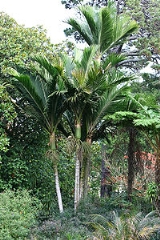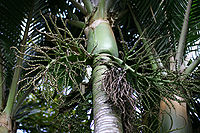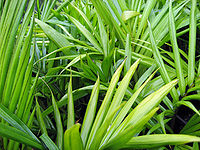
Rhopalostylis baueri
Encyclopedia
Rhopalostylis baueri is a species of palm
native to Norfolk Island
(Australia
) and to the Kermadec Islands
(New Zealand
). Norfolk Island is the type locality. The common names on Norfolk Island are 'Norfolk Island Palm' or 'Niau'. In New Zealand the name 'Kermadec Nikau' is used to refer to the Kermadec Islands population.
 On Norfolk Island it now occupies a small range in the centre of the island near the National Park, where the species is somewhat threatened by rats that eat the fruit and young seedlings. It is rare elsewhere on the island. In the Kermadec Islands part of its range it is not threatened, but it only occurs on Raoul Island
On Norfolk Island it now occupies a small range in the centre of the island near the National Park, where the species is somewhat threatened by rats that eat the fruit and young seedlings. It is rare elsewhere on the island. In the Kermadec Islands part of its range it is not threatened, but it only occurs on Raoul Island
. Following the successful eradication of rats on Raoul Island, the palm has greatly extended its range. On Norfolk Island, which is still infested with rodents, R. baueri is regenerating and is abundant in some localities. If rodents were eliminated from Norfolk, the palm would benefit greatly.
is 50–60 cm long. The inflorescence is 30 50 cm long and has from 50 to 60 fairly stout branches. The fruits are green at first, turning a bright red when ripe, and are a favorite food of the endangered Norfolk Island Parakeet. The growing tip of the palm was used by early settlers as a vegetable and is said to have tasted like a nut when raw and like an artichoke bottom when boiled.
 In the southern hemisphere outside its habitats, R. baueri is cultivated in mainland New Zealand as a faster-growing alternative to the otherwise similar R. sapida, the Nikau Palm
In the southern hemisphere outside its habitats, R. baueri is cultivated in mainland New Zealand as a faster-growing alternative to the otherwise similar R. sapida, the Nikau Palm
, the only other species in the genus Rhopalostylis
. It is also grown in the Australian states of New South Wales
, Queensland
, Victoria
, and Western Australia
. In the northern hemisphere excellent cultivated specimens are found on the coasts of the southeastern Azores and Madeira, which offer similar climates to those of the species' origin. The species is also grown outdoors in coastal California, Hawai'i, continental Portugal and Spain, the Canary Islands, and in parts of the Mediterranean basin (e.g., Palermo, Italy).
Arecaceae
Arecaceae or Palmae , are a family of flowering plants, the only family in the monocot order Arecales. There are roughly 202 currently known genera with around 2600 species, most of which are restricted to tropical, subtropical, and warm temperate climates...
native to Norfolk Island
Norfolk Island
Norfolk Island is a small island in the Pacific Ocean located between Australia, New Zealand and New Caledonia. The island is part of the Commonwealth of Australia, but it enjoys a large degree of self-governance...
(Australia
Australia
Australia , officially the Commonwealth of Australia, is a country in the Southern Hemisphere comprising the mainland of the Australian continent, the island of Tasmania, and numerous smaller islands in the Indian and Pacific Oceans. It is the world's sixth-largest country by total area...
) and to the Kermadec Islands
Kermadec Islands
The Kermadec Islands are a subtropical island arc in the South Pacific Ocean northeast of New Zealand's North Island, and a similar distance southwest of Tonga...
(New Zealand
New Zealand
New Zealand is an island country in the south-western Pacific Ocean comprising two main landmasses and numerous smaller islands. The country is situated some east of Australia across the Tasman Sea, and roughly south of the Pacific island nations of New Caledonia, Fiji, and Tonga...
). Norfolk Island is the type locality. The common names on Norfolk Island are 'Norfolk Island Palm' or 'Niau'. In New Zealand the name 'Kermadec Nikau' is used to refer to the Kermadec Islands population.
Distribution

Raoul Island
Anvil-shaped Raoul Island , the largest and northernmost of the main Kermadec Islands, , has been the source of vigorous volcanic activity during the past several thousand years that was dominated by dacitic explosive eruptions.The area of the island, including fringing islets and rocks...
. Following the successful eradication of rats on Raoul Island, the palm has greatly extended its range. On Norfolk Island, which is still infested with rodents, R. baueri is regenerating and is abundant in some localities. If rodents were eliminated from Norfolk, the palm would benefit greatly.
Description and uses
R. baueri reaches 10 m or more in height. The pinnate leaves are 3 to 4 m long, on a stout, erect petiole (leafstem) approximately 20 cm long. The crownshaftCrownshaft
An elongated circumferential leaf base formation present on some species of palm is called a crownshaft.The leaf bases of some pinnate leaved palms form a sheath at the top of the trunk surrounding the bud where all the subsequent leaves are formed.The crownshaft...
is 50–60 cm long. The inflorescence is 30 50 cm long and has from 50 to 60 fairly stout branches. The fruits are green at first, turning a bright red when ripe, and are a favorite food of the endangered Norfolk Island Parakeet. The growing tip of the palm was used by early settlers as a vegetable and is said to have tasted like a nut when raw and like an artichoke bottom when boiled.
Cultivation

Nikau
Nikau is a palm tree, the only palm endemic to New Zealand.-Etymology:Nīkau is a Māori word; in the closely related Eastern Polynesian languages of the tropical Pacific, it refers to the fronds or the midrib of the coconut palm.- Distribution:The Nikau palm is the only palm species endemic to...
, the only other species in the genus Rhopalostylis
Rhopalostylis
Rhopalostylis is a genus of two species of palms native to the South Pacific. Both are smooth-trunked, with regular ringed scars from fallen leaves. The leaves are 3–5 metres in length, and the leaf bases encircle the trunk.-Distribution:R...
. It is also grown in the Australian states of New South Wales
New South Wales
New South Wales is a state of :Australia, located in the east of the country. It is bordered by Queensland, Victoria and South Australia to the north, south and west respectively. To the east, the state is bordered by the Tasman Sea, which forms part of the Pacific Ocean. New South Wales...
, Queensland
Queensland
Queensland is a state of Australia, occupying the north-eastern section of the mainland continent. It is bordered by the Northern Territory, South Australia and New South Wales to the west, south-west and south respectively. To the east, Queensland is bordered by the Coral Sea and Pacific Ocean...
, Victoria
Victoria (Australia)
Victoria is the second most populous state in Australia. Geographically the smallest mainland state, Victoria is bordered by New South Wales, South Australia, and Tasmania on Boundary Islet to the north, west and south respectively....
, and Western Australia
Western Australia
Western Australia is a state of Australia, occupying the entire western third of the Australian continent. It is bounded by the Indian Ocean to the north and west, the Great Australian Bight and Indian Ocean to the south, the Northern Territory to the north-east and South Australia to the south-east...
. In the northern hemisphere excellent cultivated specimens are found on the coasts of the southeastern Azores and Madeira, which offer similar climates to those of the species' origin. The species is also grown outdoors in coastal California, Hawai'i, continental Portugal and Spain, the Canary Islands, and in parts of the Mediterranean basin (e.g., Palermo, Italy).

